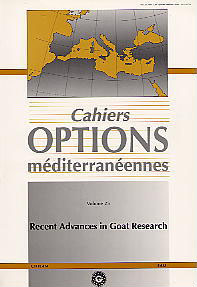| Article précédent | p. 39-45 | Article suivant |
Feeding behaviour of goats and utilisation of pasture and rangelands
Grazing goats are the backbone of most of the world's marginal land enterprises. They are capable of utilising effectively a vast variety of plant species and vegetation types. Their level of production may be comparable to that of other ungulates in the improved pastures. However, their output in degraded and low productivity areas is far beyond the production of any other domestic ungulates. Evolutionary process seems to have provided selective pressure for goats to favour the opportunistic individuals which select diet from a broader array of plant species. This is achieved by their special feeding behaviour strategy, enabling them to select proper diet and to obtain adequate nutrients for meeting their requirements for maintenance and production. An attempt is made (1) to explore the theoretical and empirical bases of feeding behaviour, (2) to examine behavioural constraints and (3) to discuss implications of foraging behaviour on production. The genetic origin, metabolic and morphological characteristics that allow goats to express this special behaviour for diet selection. In addition they are comparatively superior in relating and postingestive effects with chemical and physical plant characteristics as well as pasture structure and environmental conditions.
- [ Afficher ]
- [ Télécharger ]
- [ Exporter la citation ]
Vous pouvez télécharger la citation au format :
- [ Imprimer ]
-
Mots-clés
ALIMENTATION DES ANIMAUX, CAPRIN, PARCOURS, PATURAGECiter cet article
Nastis A.S. Feeding behaviour of goats and utilisation of pasture and rangelands. In : Morand-Fehr P. (ed.). Recent advances in goat research. Zaragoza : CIHEAM, 1997. p. 39-45. (Cahiers Options Méditerranéennes; n. 25). 6. International Conference on Goats, 1996/05/06-11, Beijing (China). http://om.ciheam.org/om/pdf/c25/97605953.pdf



